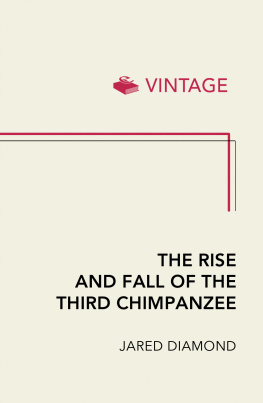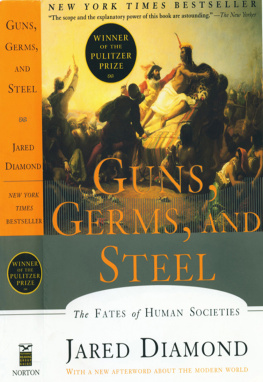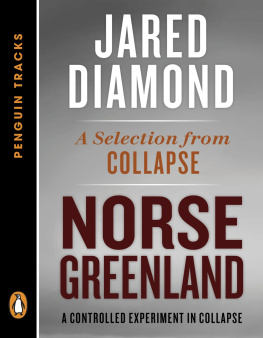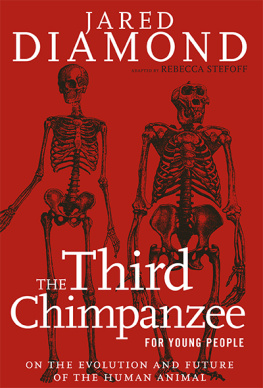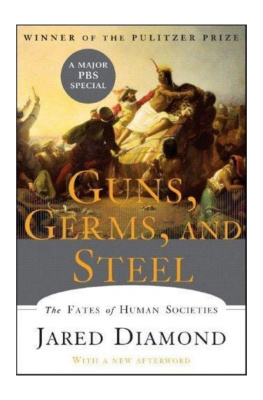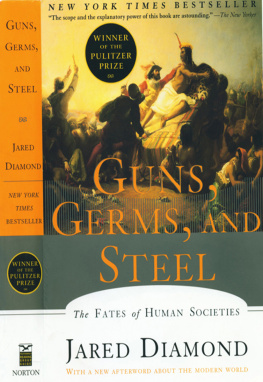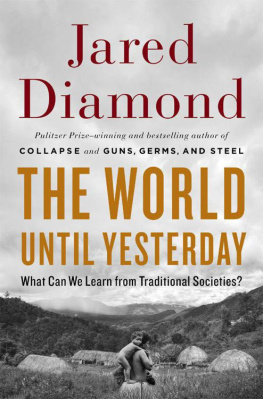
More praise for
Guns, Germs, and Steel
No scientist brings more experience from the laboratory and field, none thinks more deeply about social issues or addresses them with greater clarity, than Jared Diamond as illustrated by Guns, Germs, and Steel . In this remarkably readable book he shows how history and biology can enrich one another to produce a deeper understanding of the human condition.
Edward O. Wilson, Pellegrino University Professor, Harvard University
Serious, groundbreaking biological studies of human history only seem to come along once every generation or so.... Now Jared Diamond must be added to their select number.... Diamond meshes technological mastery with historical sweep, anecdotal delight with broad conceptual vision, and command of sources with creative leaps. No finer work of its kind has been published this year, or for many past.
Martin Sieff, Washington Times
[Diamonds] masterful synthesis is a refreshingly unconventional history informed by anthropology, behavioral ecology, linguistics, epidemiology, archeology, and technological development.
Publishers Weekly , starred review
[Jared Diamond] is broadly erudite, writes in a style that pleasantly expresses scientific concepts in vernacular American English, and deals almost exclusively in questions that should interest everyone concerned about how humanity has developed.... [He] has done us all a great favor by supplying a rock-solid alternative to the racist answer.... A wonderfully interesting book.Alfred W. Crosby, Los Angeles Times
Fascinating and extremely important.... [A] synopsis doesnt do credit to the immense subtlety of this book.
David Brown, Washington Post Book World
Deserves the attention of anyone concerned with the history of mankind at its most fundamental level. It is an epochal work. Diamond has written a summary of human history that can be accounted, for the time being, as Darwinian in its authority.Thomas M. Disch, New Leader
A wonderfully engrossing book.... Jared Diamond takes us on an exhilarating world tour of history that makes us rethink all our ideas about ourselves and other peoples and our places in the overall scheme of things.
Christopher Ehret, Distinguished Research Professor, UCLA
Jared Diamond masterfully draws together recent discoveries in fields of inquiry as diverse as archaeology and epidemiology, as he illuminates how and why the human societies of different continents followed widely divergent pathways of development over the past 13,000 years.
Bruce D. Smith, director, Archaeobiology Program, Smithsonian Institution
The question, Why did human societies have such diverse fates? has usually received racist answers. Mastering information from many different fields, Jared Diamond convincingly demonstrates that head starts and local conditions can explain much of the course of human history. His impressive account will appeal to a vast readership.
Luca Cavalli-Sforza, professor of genetics, emeritus, Stanford University
G UNS , G ERMS , AND S TEEL
THE FATES OF HUMAN SOCIETIES
Jared Diamond

W. W. Norton & Company
Independent Publishers Since 1923
New York London
To Esa, Kariniga, Omwai, Paran, Sauakari, Wiwor, and all my other New Guinea friends and teachersmasters of a difficult environment
Copyright 2017, 1999, 1997 by Jared Diamond
All rights reserved
First published as a Norton paperback 1999, reissued 2017
For information about permission to reproduce selections from
this book, write to Permissions, W. W. Norton & Company, Inc.,
500 Fifth Avenue, New York, NY 10110.
For information about special discounts for bulk purchases, please contact
W. W. Norton Special Sales at specialsales@wwnorton.com or 800-233-4830
Book design by Chris Welch
Production manager: Louise Mattarelliano
Cover design by Calvin Chu
Cover Painting: Sir John Everett Millais, Pizarro Seizing the Inca of Peru , 1845.
Victoria & Albert Museum, London / Art Resource
The Library of Congress has cataloged an earlier edition as follows:
Diamond, Jared M. Guns, germs, and steel: the fates of human societies / Jared Diamond.
p. cm.
Includes bibliographical references.
ISBN: 978-0-393-06922-8
1. Social evolution. 2. CivilizationHistory. 3. Ethnology. 4. Human beingsEffect of environment on. 5. Culture diffusion. I. Title.
HM206.D48 1997
303.4dc2196-37068 CIP
ISBN 978-0-393-60929-5 e-book
ISBN 978-0-393-35432-4 pbk.
W. W. Norton & Company, Inc.,
500 Fifth Avenue, New York, N. Y. 10110
www.wwnorton.com
W. W. Norton & Company Ltd.,
15 Carlisle Street, London W1D 3BS
C ONTENTS
The regionally differing courses of history
What happened on all the continents before 11,000 B.C. ?
How geography molded societies on Polynesian islands
Why the Inca emperor Atahuallpa did not capture King Charles I of Spain
The roots of guns, germs, and steel
Geographic differences in the onset of food production
Causes of the spread of food production
The unconscious development of ancient crops
Why did peoples of some regions fail to domesticate plants?
Why were most big wild mammal species never domesticated?
Why did food production spread at different rates on different continents?
The evolution of germs
The evolution of writing
The evolution of technology
The evolution of government and religion
The histories of Australia and New Guinea
The history of East Asia
The history of the Austronesian expansion
The histories of Eurasia and the Americas compared
The history of Africa
The history of Japan
T HIS BOOK ATTEMPTS TO PROVIDE A SHORT HISTORY OF everybody for the last 13,000 years. The question motivating the book is: Why did history unfold differently on different continents? In case this question immediately makes you shudder at the thought that you are about to read a racist treatise, you arent: as you will see, the answers to the question dont involve human racial differences at all. The books emphasis is on the search for ultimate explanations, and on pushing back the chain of historical causation as far as possible.
Most books that set out to recount world history concentrate on histories of literate Eurasian and North African societies. Native societies of other parts of the worldsub-Saharan Africa, the Americas, Island Southeast Asia, Australia, New Guinea, the Pacific Islandsreceive only brief treatment, mainly as concerns what happened to them very late in their history, after they were discovered and subjugated by western Europeans. Even within Eurasia, much more space gets devoted to the history of western Eurasia than of China, India, Japan, tropical Southeast Asia, and other eastern Eurasian societies. History before the emergence of writing around 3,000 B.C. also receives brief treatment, although it constitutes 99.9% of the five-million-year history of the human species.
Such narrowly focused accounts of world history suffer from three disadvantages. First, increasing numbers of people today are, quite understandably, interested in other societies besides those of western Eurasia. After all, those other societies encompass most of the worlds population and the vast majority of the worlds ethnic, cultural, and linguistic groups. Some of them already are, and others are becoming, among the worlds most powerful economies and political forces.
Second, even for people specifically interested in the shaping of the modern world, a history limited to developments since the emergence of writing cannot provide deep understanding. It is not the case that societies on the different continents were comparable to each other until 3,000 B.C. , whereupon western Eurasian societies suddenly developed writing and began for the first time to pull ahead in other respects as well. Instead, already by 3,000 B.C. , there were Eurasian and North African societies not only with incipient writing but also with centralized state governments, cities, widespread use of metal tools and weapons, use of domesticated animals for transport and traction and mechanical power, and reliance on agriculture and domestic animals for food. Throughout most or all parts of other continents, none of those things existed at that time; some but not all of them emerged later in parts of the Native Americas and sub-Saharan Africa, but only over the course of the next five millennia; and none of them emerged in Aboriginal Australia. That should already warn us that the roots of western Eurasian dominance in the modern world lie in the preliterate past before 3,000 B.C. (By western Eurasian dominance, I mean the dominance of western Eurasian societies themselves and of the societies that they spawned on other continents.)
Next page

